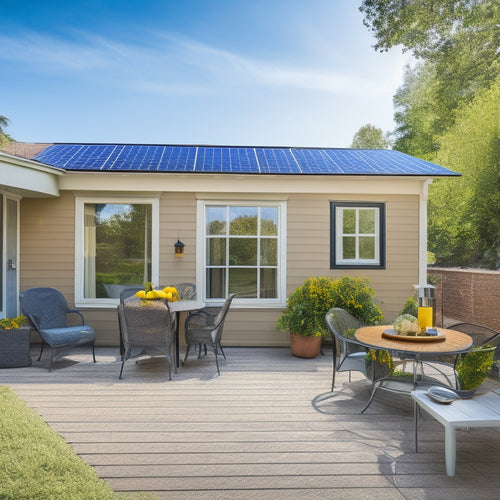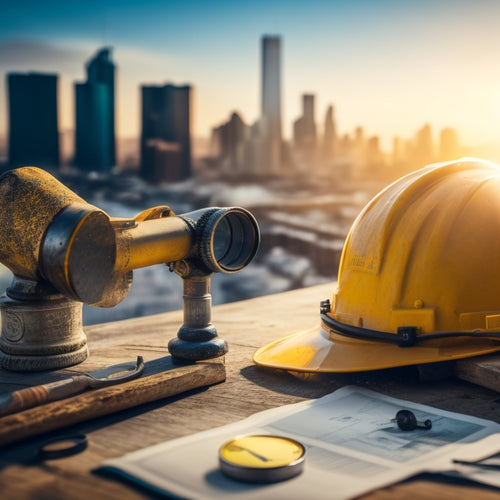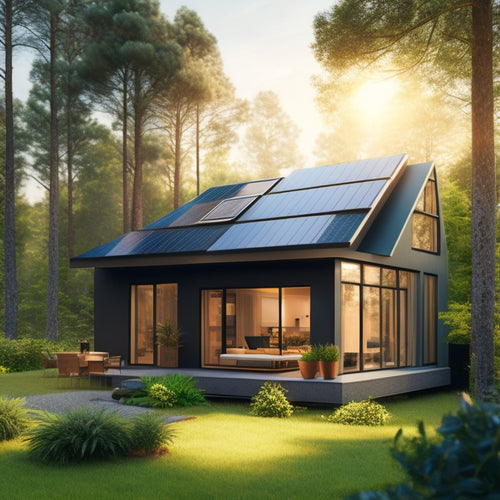
Optimize Energy Consumption for Small Businesses
Share
You can optimize energy consumption in your small business by identifying areas of waste and implementing changes to improve efficiency. Start by conducting an energy audit to pinpoint opportunities for improvement. Then, switch to energy-efficient lighting and optimize your HVAC system's performance. Utilize energy consumption monitoring tools and automate energy-saving habits. Don't forget to engage your employees in energy-saving efforts and consider upgrading to renewable energy sources. By implementing these strategies, you'll be well on your way to reducing energy expenses and minimizing your environmental impact. Now, take the next step to uncover more opportunities to boost your bottom line.
Key Takeaways
• Conduct energy audits to identify consumption patterns and wasteful opportunities, and prioritize energy-saving initiatives accordingly.
• Implement energy-efficient lighting, such as LED bulbs, to reduce operating costs and environmental impact.
• Optimize HVAC systems by ensuring correct sizing, cleaning air filters, and scheduling maintenance checks to reduce energy consumption.
• Utilize energy tracking systems and analytics to monitor usage in real-time, enabling quick responses to inefficiencies and waste.
• Engage employees through education and incentives, encouraging energy-efficient habits and promoting a culture of sustainability.
Energy Waste Identification Strategies
To identify areas of energy waste in your small business, start by conducting a thorough energy audit, which involves tracking your energy usage patterns and pinpointing opportunities for improvement. This process helps you understand how energy is being used in your facility, identifying areas of inefficiency and opportunities for cost savings.
One effective strategy is energy mapping, which involves creating a visual representation of your energy usage to identify patterns and trends. By analyzing your energy usage patterns, you can identify areas where energy is being wasted and prioritize improvements.
Additionally, many utility companies offer incentives for small businesses that implement energy-efficient practices, such as rebates for energy-efficient equipment upgrades. Take advantage of these utility incentives to offset the costs of energy-saving initiatives.
Conducting Energy Audits Effectively
By following a structured approach, you can guarantee that your energy audit is thorough and efficient in identifying areas of energy waste in your small business. A well-planned audit preparation is vital to achieving this goal. It involves gathering data on your energy consumption patterns, identifying areas of energy waste, and prioritizing energy-saving opportunities.
To guarantee a detailed energy analysis, consider the following steps:
| Step | Task | Benefits |
|---|---|---|
| 1. Review Energy Bills | Analyze past energy bills to identify patterns and trends | Identifies areas of high energy consumption |
| 2. Conduct On-Site Inspection | Inspect lighting, HVAC, and equipment to identify energy-wasting opportunities | Reveals hidden energy-wasting areas |
| 3. Install Energy Monitoring Devices | Track real-time energy usage to identify areas of inefficiency | Provides actionable insights for energy reduction |
Implementing Energy Efficient Lighting
As you explore ways to lower energy consumption in your small business, implementing energy-efficient lighting is a great place to start.
You'll want to explore LED lighting options, which can greatly cut down on energy usage.
LED Lighting Options
You can greatly reduce your small business's energy consumption by switching to LED lighting options, which use up to 90% less energy than traditional incandescent bulbs. LED lighting is a cost-effective and environmentally friendly solution that can have a substantial impact on your energy consumption.
When selecting LED lighting options, consider the color temperature, which refers to the light's warmth or coolness. Warm white light (2700K-3000K) is ideal for cozy spaces, while cool white light (3500K-4100K) is better suited for task-oriented areas.
Dimmable fixtures are also a great option, allowing you to adjust the light level to suit your business's needs. This feature is particularly useful in areas where lighting requirements vary, such as in restaurants or retail spaces.
Benefits of Retrofitting
Retrofitting with energy-efficient lighting can greatly reduce your small business's energy consumption and operating costs, leading to substantial savings over time. By upgrading to energy-efficient lighting, you'll not only reduce your energy consumption but also lower your environmental impact. This, in turn, can enhance your business's reputation and appeal to environmentally conscious customers.
Retrofitting with energy-efficient lighting can also bring significant financial gains. Many utility companies and government agencies offer retrofit incentives, such as rebates and tax credits, to encourage businesses to adopt energy-efficient practices. These incentives can help offset the upfront costs of retrofitting, making it a more affordable and attractive option.
Additionally, energy-efficient lighting can last up to 25 times longer than traditional lighting, reducing maintenance costs and downtime. By retrofitting with energy-efficient lighting, you can enjoy long-term financial gains while doing your part for the environment.
Optimizing HVAC Systems Performance
By fine-tuning your HVAC system's performance, you can significantly reduce energy consumption and lower your energy bills. As a small business owner, optimizing your heating, ventilation, and air conditioning (HVAC) system is crucial to create a comfortable and healthy indoor environment for your employees and customers.
To achieve this, consider the following optimizations:
-
System Sizing: Make sure your HVAC system is correctly sized for your business. An oversized system will waste energy, while an undersized system will struggle to maintain a comfortable temperature.
-
Air Quality: Regularly clean and replace air filters to maintain good air quality and reduce energy consumption. A dirty filter can increase energy consumption by up to 15%.
-
Regular Maintenance: Schedule routine maintenance checks to identify and fix any issues before they become major problems.
- Smart Thermostats: Install smart thermostats to optimize temperature control and automate energy-saving strategies, such as scheduling temperature adjustments when your business is closed.
Energy Consumption Monitoring Tools
When optimizing your small business's energy consumption, having the right tools in place to monitor your energy usage is crucial. Energy consumption monitoring tools provide you with valuable insights into your energy usage patterns, helping you identify areas for improvement.
With these tools, you'll gain access to energy tracking systems, real-time usage data, and automated energy audits that will help you make informed decisions about your energy consumption.
Energy Tracking Systems
You can gain a deeper understanding of your energy usage patterns by investing in energy tracking systems, which provide real-time monitoring and analysis of your energy consumption. This allows you to identify areas of inefficiency and make data-driven decisions to optimize your energy usage.
With energy tracking systems, you can:
-
Integrate energy analytics into your existing infrastructure, providing a thorough view of your energy consumption.
-
Monitor energy usage in real-time, enabling you to respond quickly to anomalies or inefficiencies.
-
Analyze energy usage patterns, identifying opportunities to reduce waste and optimize energy consumption.
- Integrate with existing systems, such as building management systems or HVAC systems, to create a seamless and efficient energy management solution.
Real-Time Usage Data
Real-time usage data from energy consumption monitoring tools provides a granular view of your energy usage, empowering you to pinpoint areas of inefficiency and take corrective action promptly.
With smart meters and advanced data analytics, you can track your energy consumption in real-time, identifying patterns and trends that inform your energy-saving strategies. This level of transparency enables you to make data-driven decisions, rather than relying on estimates or rough estimates.
Additionally, by leveraging real-time usage data, you can identify opportunities to optimize your energy consumption, such as adjusting your lighting schedules, optimizing HVAC systems, or streamlining production processes.
Furthermore, you can set alerts and notifications to alert you to unusual usage patterns, allowing you to address potential issues before they escalate.
Automated Energy Audits
Automated energy audits, made possible by advanced energy consumption monitoring tools, streamline the process of identifying energy-saving opportunities, providing actionable insights that help you prioritize and implement energy-efficient solutions. By leveraging these tools, you can optimize energy consumption and reduce waste.
Here are some key benefits of automated energy audits:
-
Energy Mapping: Automated energy audits provide detailed energy maps, helping you visualize energy usage patterns and identify areas of inefficiency.
-
Frequent Audits: With automated energy audits, you can conduct energy audits at a higher frequency, ensuring that your energy-saving strategies remain effective and up-to-date.
-
Data-Driven Insights: Automated energy audits provide accurate and reliable data, enabling you to make informed decisions about energy-efficient upgrades and retrofits.
- Cost Savings: By identifying energy-saving opportunities and implementing energy-efficient solutions, you can notably reduce your energy costs and boost your bottom line.
Renewable Energy Sources for SMBs
Small to medium-sized businesses (SMBs) can greatly diminish their carbon footprint and energy expenses by integrating renewable energy sources into their operations. As a small business owner, you're likely looking for ways to reduce your energy bills while also doing your part for the environment.
Renewable energy sources, such as solar power, offer a viable solution. By investing in solar panels, you can take advantage of solar incentives, such as tax credits and rebates, which can help offset the initial installation costs. Additionally, community partnerships can provide access to shared resources and expertise, making it easier to shift towards renewable energy.
Energy Efficiency in Commercial Kitchens
As you oversee daily kitchen operations, you're likely aware that commercial kitchens are notorious energy guzzlers, with appliances, lighting, and HVAC systems combining to create a significant drain on your energy resources.
However, with a few strategic tweaks, you can optimize your kitchen's energy efficiency and reduce your energy consumption.
Here are some practical tips to get you started:
-
Optimize your kitchen layout: Make sure that your kitchen is laid out to minimize walking distances and reduce the need for unnecessary equipment usage.
-
Maintain your equipment: Regularly clean and maintain your appliances to make sure they're running efficiently. Clean or replace air filters, and inspect door seals to prevent heat loss.
-
Upgrade to energy-efficient equipment: Consider replacing old appliances with energy-efficient alternatives, such as LED refrigerators or Energy Star-certified dishwashers.
- Implement energy-saving habits: Encourage staff to turn off lights and equipment when not in use, and consider installing occupancy sensors to automate lighting controls.
Employee Engagement and Education
You can greatly reduce energy consumption by empowering your staff to take ownership of energy efficiency, and it starts with educating them on the importance of this effort. By making your employees aware of the impact of their daily actions on energy consumption, you can encourage them to make small changes that add up to significant savings.
Consider establishing an Energy Champions program, where a team of dedicated staff members takes the lead in promoting energy-efficient practices throughout the organization. This team can help identify areas of improvement, develop strategies for reducing energy waste, and promote energy-saving habits among their colleagues.
As you educate your staff, be sure to emphasize the benefits of energy efficiency, such as cost savings, environmental sustainability, and enhanced reputation. You can also create a Green Team, comprising employees from various departments, to brainstorm innovative ideas for reducing energy consumption.
Energy Savings Through Automation
Implement automated systems and smart devices to streamline energy consumption and access significant energy savings in your small business. By leveraging automation, you can optimize energy usage, reduce waste, and lower your energy bills.
Here are some ways to get started:
-
Smart Plugs: Install smart plugs to control and monitor individual devices, allowing you to turn them off remotely or schedule on/off times to avoid standby power consumption.
-
Energy Hubs: Invest in energy hubs that integrate with your existing systems, enabling real-time energy monitoring and automated control over your energy usage.
-
Scheduled Power Cycles: Implement scheduled power cycles to turn off devices during non-operational hours, reducing energy waste and prolonging device lifespan.
- Automated Lighting Controls: Install automated lighting controls that adjust brightness and color based on natural light availability, time of day, or occupancy, reducing energy consumption and enhancing ambiance.
Measuring Energy Efficiency Success
Now that you've implemented energy-saving measures, it's crucial to track your progress to guarantee you're meeting your energy efficiency goals.
To do this, you'll need to establish an energy baseline, identify key performance indicators, and set up a system to track metrics that measure your progress.
Energy Baseline Establishment
Establishing a reliable energy baseline is essential to measuring the success of your energy efficiency efforts, as it provides a clear understanding of your current energy consumption patterns. This baseline serves as a benchmark to track your progress and identify areas for improvement.
To establish a solid energy baseline, you'll need to gather and analyze your energy usage data.
Here are some key steps to follow:
-
Review utility invoices: Collect and review your past utility invoices to understand your energy consumption patterns.
-
Conduct energy mapping: Create an energy map to identify areas of high energy usage in your facility.
-
Identify energy-intensive equipment: Pinpoint equipment that consumes the most energy and prioritize energy-efficient upgrades.
- Set energy targets: Establish realistic energy reduction targets based on your current energy consumption patterns.
Key Performance Indicators
By analyzing your energy baseline data, you can identify key performance indicators (KPIs) that will help you measure the success of your energy efficiency efforts and track progress toward your energy reduction targets. These KPIs serve as benchmarks to evaluate your energy goals and provide insights into areas that require improvement.
When selecting KPIs, focus on metrics that align with your energy goals and objectives. Some common performance metrics include:
- Energy consumption per square foot
- Energy cost per unit
- Carbon footprint
You can also track metrics like the number of energy-efficient upgrades completed, energy savings achieved, and return on investment (ROI) for energy-efficient projects.
Metric Tracking Progress
Track your energy efficiency progress by regularly reviewing your KPIs, which will help you stay focused on your goals and make data-driven decisions to optimize energy consumption in your small business. By monitoring your progress, you'll be able to identify areas that need improvement and make adjustments to your energy-saving strategies accordingly.
To effectively track your progress, consider the following:
-
Data Validation: Verify the accuracy of your energy consumption data to confirm that your progress metrics are reliable and trustworthy.
-
Regular Progress Visualization: Use charts, graphs, or other visualization tools to help you quickly understand your progress and identify trends or patterns.
-
Set Realistic Targets: Establish achievable goals for energy reduction and track your progress towards meeting those targets.
- Conduct Regular Reviews: Schedule regular review sessions to assess your progress, identify areas for improvement, and adjust your strategies as needed.
Frequently Asked Questions
How Often Should Energy Audits Be Conducted for Optimal Energy Consumption?
'As you begin the energy-saving journey, you'll want to conduct energy audits every 2-3 years, like a regular check-up, to identify areas for improvement and maximize energy savings, ensuring your business stays on the path to peak energy consumption.'
Are Energy-Efficient Appliances Also Cost-Effective for Small Businesses?
'When you invest in energy-efficient appliances, it's important to take into account the payback period and lifecycle costs. You'll find that many options are cost-effective, with some even paying for themselves within a few years, making them a smart choice for your small business.'
Can Solar Panels Be Installed on Rooftops With Limited Space?
You can still harness solar power even with limited rooftop space. Consider a space-optimized layout, strategically placing panels to maximize energy output. With careful planning, you can generate significant energy savings, even on a small rooftop.
Do Energy-Efficient Upgrades Qualify for Government Incentives or Tax Credits?
You'll be happy to know that many energy-efficient upgrades qualify for federal rebates and state credits, which can greatly offset the costs, making it more feasible for you to invest in a sustainable future.
Can Energy Consumption Monitoring Tools Be Integrated With Existing Systems?
You can integrate energy consumption monitoring tools with your existing systems, ensuring system compatibility and seamless data visualization, allowing you to track and optimize energy usage effectively.
Related Posts
-

10 Tips to Buy Affordable Solar Panels Online
When purchasing affordable solar panels online, you'll want to research reputable retailers, compare prices, and chec...
-

What You Need to Know About Permits and Inspections
You need to navigate the complex landscape of permits and inspections to guarantee your project complies with local z...
-

Reduce Solar Panel Cost for Your Small Home
By evaluating your energy needs, choosing the right installer, and selecting cost-effective solar panel options, you ...


